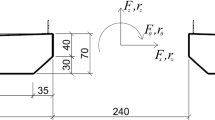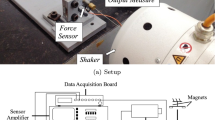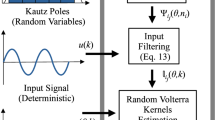Abstract
In the last decades, the Volterra series theory has been used to construct reduced-order models of nonlinear systems in engineering and applied sciences. For the particular case of weakly nonlinear aerodynamic and aeroelastic systems, the Volterra series theory has been tested as an alternative to the high computing costs of CFD methods. The Volterra series model determination depends on identifying the kernels associated with the respective convolution integrals. The Volterra kernels identification has been tried in many ways, but the majority of them addresses only the direct kernels of single-input, single-output nonlinear systems. However, multiple-input, multiple-output relations are the most typical case for many dynamic systems. In this case, the so-called Volterra cross-kernels represent the internal couplings between multiple inputs. Not many generalizations of the single-input kernel identification methods to multi-input Volterra kernels are available in the literature. This work proposes a methodology for the identification of Volterra direct kernels and cross-kernels, which is based on time-delay neural networks and the relationship between the kernels functions and the internal parameters of the network. Expressions to derive the pth-order Volterra direct kernels and cross-kernels from the internal parameters of a trained time-delay neural network are derived. The method is checked with a two-degree-of-freedom, two-input, one-output nonlinear system to demonstrate its capabilities. The application to a mildly nonlinear unsteady aerodynamic loading due to pitching and heaving motions of an airfoil is also evaluated. The Volterra direct kernels and cross-kernels of up to third order are successfully identified using training datasets computed with CFD simulations of the Euler equations. Comparisons between CFD simulations and Volterra model predictions are presented, thereby ensuring the potential of the method to systematically extract kernels from neural networks.












Similar content being viewed by others
Notes
\(k=\left( \frac{\omega b}{U_{\infty }}\right) \), where \(\omega \) is the angular frequency, and \(b=c/2\) is the airfoil semi-chord.
References
Volterra, V.: Theory of Functionals and of Integral and Integro-differential Equations. Dover Books on Mathematics Series. Dover Publications, New York (2005)
Yamanaka, O., Ohmori, H., Sano, A.: Design method of exact model matching control for finite Volterra series systems. Int. J. Control 68(1), 107–124 (1997). https://doi.org/10.1080/002071797223758
Silva, W.A.: Identification of nonlinear aeroelastic systems based on the Volterra theory: progress and opportunities. Nonlinear Dyn. 39(1), 25–62 (2005). https://doi.org/10.1007/s11071-005-1907-z
Peng, Z.K., Lang, Z.Q., Billings, S.A.: Analysis of locally nonlinear MDOF systems using nonlinear output frequency response functions. J. Vib. Acoust. 131(5), 051007–051007-10 (2009). https://doi.org/10.1115/1.3147139
Wu, T., Kareem, A.: Vortex-induced vibration of bridge decks: Volterra series-based model. J. Eng. Mech. 139(12), 1831–1843 (2013). https://doi.org/10.1061/(ASCE)EM.1943-7889.0000628
Billings, S.A.: Identification of nonlinear systems—a survey. IEE Proc. D Control Theory Appl. 127(6), 272–285 (1980). https://doi.org/10.1049/ip-d:19800047
Cheng, C.M., Peng, Z.K., Zhang, W.M., Meng, G.: Volterra-series-based nonlinear system modeling and its engineering applications: a state-of-the-art review. Mech. Syst. Signal Process. 87, 340–364 (2017). https://doi.org/10.1016/j.ymssp.2016.10.029
Schetzen, M.: The Volterra and Wiener Theories of Nonlinear Systems. Wiley, New York (1980)
Franz, M.O., Schölkopf, B.: A unifying view of Wiener and Volterra theory and polynomial kernel regression. Neural Comput. 18(12), 3097–3118 (2006). https://doi.org/10.1162/neco.2006.18.12.3097
Vanbeylen, L., Pintelon, R., Schoukens, J.: Blind maximum-likelihood identification of Wiener systems. IEEE Trans. Signal Process. 57(8), 3017–3029 (2009). https://doi.org/10.1109/TSP.2009.2017001
Billings, S.A., Fakhouki, S.Y.: Nonlinear system identification using the Hammerstein model. Int. J. Syst. Sci. 10(5), 567–578 (1979). https://doi.org/10.1080/00207727908941603
Hunter, I.W., Korenberg, M.J.: The identification of nonlinear biological systems: Wiener and Hammerstein cascade models. Biol. Cybern. 55, 135–144 (1986). https://doi.org/10.1007/BF00341929
Korenberg, M.J., Hunter, I.W.: The identification of nonlinear biological systems: LNL cascade models. Biol. Cybern. 55, 125–134 (1986). https://doi.org/10.1007/BF00341928
Sjöberg, J., Schoukens, J.: Initializing Wiener–Hammerstein models based on partitioning of the best linear approximation. Automatica 48(2), 353–359 (2012). https://doi.org/10.1016/j.automatica.2011.07.007
Guo, Y., Guo, L.Z., Billings, S.A., Coca, D., Lang, Z.Q.: Volterra series approximation of a class of nonlinear dynamical systems using the Adomian decomposition method. Nonlinear Dyn. 74(1), 359–371 (2013). https://doi.org/10.1007/s11071-013-0975-8
Marmarelis, P.Z., Naka, K.: Identification of multi-input biological systems. IEEE Trans. Biomed. Eng. BME–21(2), 88–101 (1974). https://doi.org/10.1109/TBME.1974.324293
Marmarelis, P.Z., Marmarelis, V.: Analysis of Physiological Systems: The White-Noise Approach. Plenum Press, New York (1978)
Worden, K., Manson, G., Tomlinson, G.R.: A harmonic probing algorithm for the multi-input Volterra series. J. Sound Vib. 201(1), 67–84 (1997). https://doi.org/10.1006/jsvi.1996.0746
Chatterjee, A., Vyas, N.A.: Non-linear parameter estimation in multi-degree-of-freedom systems using multi-input Volterra series. Mech. Syst. Signal Process. 18(3), 457–489 (2004). https://doi.org/10.1016/S0888-3270(03)00016-5
Wray, J., Green, G.G.R.: Calculation of the Volterra kernels of non-linear dynamic systems using an artificial neural network. Biol. Cybern. 71(3), 187–195 (1994). https://doi.org/10.1007/BF00202758
Stegmayer, G., Chiotti, O.: Identification of frequency-domain Volterra model using neural networks. In: Duch, W., Kacprzyk, J., Oja, E., Zadrożny, S. (eds.) Artificial Neural Networks: Formal Models and Their Applications—ICANN 2005, pp. 465–471. Springer, Berlin (2005). https://doi.org/10.1007/11550907_73
Stegmayer, G., Chiotti, O.: Volterra NN-based behavioral model for new wireless communications devices. Neural Comput. Appl. 18(3), 283–291 (2009). https://doi.org/10.1007/s00521-008-0180-8
Mišić, J., Marković, V., Marinković, Z.: Volterra kernels extraction from neural networks for amplifier behavioral modeling. In: 2014 X International Symposium on Telecommunications (BIHTEL), pp. 1–6 (2014). https://doi.org/10.1109/BIHTEL.2014.6987646
Silva, W.A.: Application of nonlinear systems theory to transonic unsteady aerodynamic responses. J. Aircr. 30(5), 660–668 (1993). https://doi.org/10.2514/3.46395
Silva, W.A.: Reduced-order models based on linear and nonlinear aerodynamic impulse responses. In: 40th Structures, Structural Dynamics, and Materials Conference and Exhibit, St. Louis, MO, USA (1999). https://doi.org/10.2514/6.1999-1262. AIAA-99-1262
Silva, W.A., Beran, P.S., Cesnik, C.E.S., Guendel, R.E., Kurdila, A., Prazenica, R.J., Librescu, L., Marzocca, P., Raveh, D.E.: Reduced-order modeling: cooperative research and development at the NASA Langley Research Center. In: CEAS/AIAA/AIAE International Forum on Aeroelasticity and Structural Dynamics – IFASD, pp. 1–16, Madrid, Spain (2001). IFASD-2001-008
Marzocca, P., Silva, W.A., Librescu, L.: Nonlinear open-/closed-loop aeroelastic analysis of airfoils via Volterra series. AIAA J. 42(4), 673–686 (2004). https://doi.org/10.2514/1.9552
Lucia, D.J., Beran, P.S., Silva, W.A.: Reduced-order modeling: new approaches for computational physics. Prog. Aerosp. Sci. 40(1), 51–117 (2004). https://doi.org/10.1016/j.paerosci.2003.12.001
Balajewicz, M., Nitzsche, F., Feszty, D.: Application of multi-input Volterra theory to nonlinear multi-degree-of-freedom aerodynamic systems. AIAA J. 48(1), 56–62 (2010). https://doi.org/10.2514/1.38964
Balajewicz, M., Dowell, E.: Reduced-order modeling of flutter and limit-cycle oscillations using the sparse Volterra series. J. Aircr. 49(6), 1803–1812 (2012). https://doi.org/10.2514/1.C031637
de Paula, N.C.G., Marques, F.D., Silva, W.A.: Volterra kernels assessment via time-delay neural networks for nonlinear unsteady aerodynamic loading identification. AIAA J. (2019). https://doi.org/10.2514/1.J057229
Bogacki, P., Shampine, L.F.: A 3 (2) pair of Runge–Kutta formulas. Appl. Math. Lett. 2(4), 321–325 (1989). https://doi.org/10.1016/0893-9659(89)90079-7
Hagan, M.T., Demuth, H.B., Beale, M.H., de Jess, O.: Neural Network Design, 2nd edn. Martin Hagan (2014). ISBN 0971732116, 9780971732117
Camilo, E., Marques, F.D., Azevedo, J.L.F.: Hopf bifurcation analysis of typical sections with structural nonlinearities in transonic flow. Aerosp. Sci. Technol. 30(1), 163–174 (2013). https://doi.org/10.1016/j.ast.2013.07.013
Raveh, D.E.: Reduced-order models for nonlinear unsteady aerodynamics. AIAA J. 39(8), 1417–1429 (2001). https://doi.org/10.2514/2.1473
Landon, R.H., Davis, S.S.: Compendium of unsteady aerodynamic measurements. Technical Report R-702, AGARD—Advisory Group for Aerospace Research and Development (NATO) (1982)
Acknowledgements
The authors acknowledge the financial support of: Grant 2017/02926-9, São Paulo Research Foundation (FAPESP) and Grants 307658/2016-3 and 131493/2016-7, National Council for Scientific and Technological Development (CNPq).
Author information
Authors and Affiliations
Corresponding author
Ethics declarations
Conflict of interest
The authors declare that there is no conflict of interest regarding the publication of this paper.
Additional information
Publisher's Note
Springer Nature remains neutral with regard to jurisdictional claims in published maps and institutional affiliations.
Rights and permissions
About this article
Cite this article
de Paula, N.C.G., Marques, F.D. Multi-variable Volterra kernels identification using time-delay neural networks: application to unsteady aerodynamic loading. Nonlinear Dyn 97, 767–780 (2019). https://doi.org/10.1007/s11071-019-05011-8
Received:
Accepted:
Published:
Issue Date:
DOI: https://doi.org/10.1007/s11071-019-05011-8




